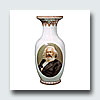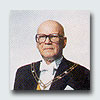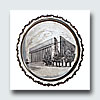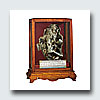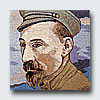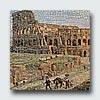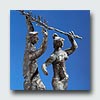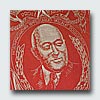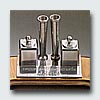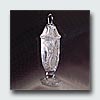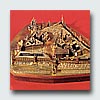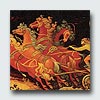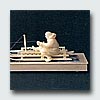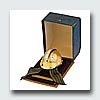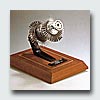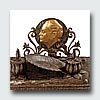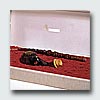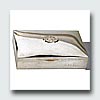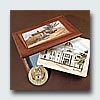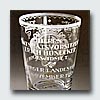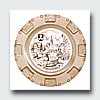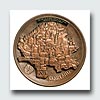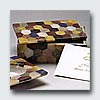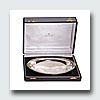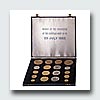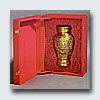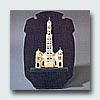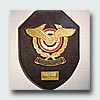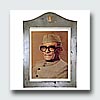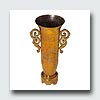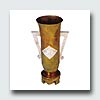|
Official Gifts from Abroad
by Andreas Michaelis
 The
GDR was a child of the Cold War. Two German states evolved in the post-'45
period as a result of the Allies' realisation that neither the western
democracies nor the Soviet Union would be able to impose their differing
socio-political systems throughout all Germany. From the outset, the GDR
was on the defensive. It was founded at a time when many countries had
already recognised the Federal Republic as the legitimate, sovereign heir
to the defeated Third Reich. The West German parliament and government
were equipped with democratic credentials, and the West German economy
was soon well on the way to its famous miraculous recovery. The majority
of the victorious powers of the Second World War, and thus most of the
West, stood behind the Federal Republic. The GDR, by contrast, seemed
the Soviet Union's political outpost in central Europe, a bastion rifted
with strategic interests; and the West neither recognised its right to
exist nor gave it a chance to survive. Thus, from the very beginning,
the German Democratic Republic had a hard time winning international recognition.
It was in the nature of things that the first countries to establish diplomatic
relations with the GDR were the Soviet Union and its East European satellites,
and in October 1949 the People's Republic of China, and Korea, became
the first non-European countries to follow suit. And that, indeed, was
already very nearly all the countries prepared to see East Germany as
an equal partner. This inevitably exerted a constricting influence on
the GDR's options when it came to presenting an international image. The
GDR was a child of the Cold War. Two German states evolved in the post-'45
period as a result of the Allies' realisation that neither the western
democracies nor the Soviet Union would be able to impose their differing
socio-political systems throughout all Germany. From the outset, the GDR
was on the defensive. It was founded at a time when many countries had
already recognised the Federal Republic as the legitimate, sovereign heir
to the defeated Third Reich. The West German parliament and government
were equipped with democratic credentials, and the West German economy
was soon well on the way to its famous miraculous recovery. The majority
of the victorious powers of the Second World War, and thus most of the
West, stood behind the Federal Republic. The GDR, by contrast, seemed
the Soviet Union's political outpost in central Europe, a bastion rifted
with strategic interests; and the West neither recognised its right to
exist nor gave it a chance to survive. Thus, from the very beginning,
the German Democratic Republic had a hard time winning international recognition.
It was in the nature of things that the first countries to establish diplomatic
relations with the GDR were the Soviet Union and its East European satellites,
and in October 1949 the People's Republic of China, and Korea, became
the first non-European countries to follow suit. And that, indeed, was
already very nearly all the countries prepared to see East Germany as
an equal partner. This inevitably exerted a constricting influence on
the GDR's options when it came to presenting an international image.
The GDR's first foreign policy contacts with the Soviet Union were apparently
viewed as working sessions: neither Foreign Minister Andrei J. Vyshinsky's
visit in December 1949, nor that of Nikolai Mikhailovich Shvernik, Chairman
of the Presidium of the Supreme Soviet, were documented in the »special
inventory«. Nor does the Deutsches Historisches Museum possess any mementoes
of the first official state visit to the Soviet Union by representatives
of the GDR.
 At
a level below the topmost leadership, though, there was a brisk and continuing
exchange of delegations, and some items have survived to recall these.
This chapter, for instance, opens with a souvenir Fred Oelssner, by his
own account, was given on a visit to the USSR in 1949 or 1950. From 1950
to 1958, Oelssner was a member of the Party executive and also held a
variety of state offices, so the present presumably belongs in the category
of gifts to members of government. The gift in question is a model of
the Spasski Tower on the Kremlin in Moscow, with a clock built into it.
The Russian inscription reads: »Onward, ever onward, onward to victory«.
Until 1972, the piece was in the private keeping of the Oelssner family,
and was donated to the Museum für Deutsche Geschichte when that body
enquired after it. At
a level below the topmost leadership, though, there was a brisk and continuing
exchange of delegations, and some items have survived to recall these.
This chapter, for instance, opens with a souvenir Fred Oelssner, by his
own account, was given on a visit to the USSR in 1949 or 1950. From 1950
to 1958, Oelssner was a member of the Party executive and also held a
variety of state offices, so the present presumably belongs in the category
of gifts to members of government. The gift in question is a model of
the Spasski Tower on the Kremlin in Moscow, with a clock built into it.
The Russian inscription reads: »Onward, ever onward, onward to victory«.
Until 1972, the piece was in the private keeping of the Oelssner family,
and was donated to the Museum für Deutsche Geschichte when that body
enquired after it.
 In
December 1950, Wilhelm Pieck paid his first official state visit to neighbouring
Poland as President of the GDR. A small brass sculpture given to Pieck
when he visited the Ursus works in Warsaw still recalls the occasion. In
December 1950, Wilhelm Pieck paid his first official state visit to neighbouring
Poland as President of the GDR. A small brass sculpture given to Pieck
when he visited the Ursus works in Warsaw still recalls the occasion.
 But
of greater weight, in a perfectly literal sense of the word, is the present
brought by Polish President Boleslaw Bierut when he made his return visit
to East Germany in April 1951. The bronze statue of King Sigismund III
Wasa of Poland (1587-1632) and Sweden (1592-1603), mounted on a solid
marble plinth, is a miniature of the monument in Warsaw, and weighs in
at a full two hundredweight. In the early 1950s, gifts made by East European
countries generally made some reference to national history or to native
cultural traditions; later, this emphasis was largely displaced by symbolic
references to the workers' movement and socialist institutions. The tendency
is already apparent in a czech bronze statuette of a welder that Pieck
was given on his second and last state visit in October 1951. But
of greater weight, in a perfectly literal sense of the word, is the present
brought by Polish President Boleslaw Bierut when he made his return visit
to East Germany in April 1951. The bronze statue of King Sigismund III
Wasa of Poland (1587-1632) and Sweden (1592-1603), mounted on a solid
marble plinth, is a miniature of the monument in Warsaw, and weighs in
at a full two hundredweight. In the early 1950s, gifts made by East European
countries generally made some reference to national history or to native
cultural traditions; later, this emphasis was largely displaced by symbolic
references to the workers' movement and socialist institutions. The tendency
is already apparent in a czech bronze statuette of a welder that Pieck
was given on his second and last state visit in October 1951.
 Figures
of workers, usually idealized, were stand-bys of the visual arts in Communist
countries, especially when commissioned by the Party. Small wonder, then,
that the »Special Inventory« of the Deutsches Historisches Museum includes
several dozen sculptures of miners, steelworkers, foresters or agricultural
labourers. Doctrine held that the working classes played the lead role,
and this belief naturally required expression in art. Figures
of workers, usually idealized, were stand-bys of the visual arts in Communist
countries, especially when commissioned by the Party. Small wonder, then,
that the »Special Inventory« of the Deutsches Historisches Museum includes
several dozen sculptures of miners, steelworkers, foresters or agricultural
labourers. Doctrine held that the working classes played the lead role,
and this belief naturally required expression in art.
In the 1950s, state visits to the GDR were infrequent, and when they occurred
they were occasions marked by wide public interest and celebration. The
first heads of state to visit, needless to say, were those from neighbouring
socialist countries.  After
Boleslaw Bierut, Czechoslovak President Clement Gottwald visited East
Germany in March 1952. One of the presents he brought with him was a group
of figures, a product of traditional Bohemian glass-blowing craft. These
working class figures are unmarred by slick emotionalism or shallow class
symbolism, and in this respect afford welcome relief from other exhibits
of a more bombastic, heroic character. After
Boleslaw Bierut, Czechoslovak President Clement Gottwald visited East
Germany in March 1952. One of the presents he brought with him was a group
of figures, a product of traditional Bohemian glass-blowing craft. These
working class figures are unmarred by slick emotionalism or shallow class
symbolism, and in this respect afford welcome relief from other exhibits
of a more bombastic, heroic character.
 The
next eminent guest of the GDR was Mátyás Rákosi,
Prime Minister of Hungary. One of the gifts he brought with him in October
1952 was a tapestry portraying the Hungarian national poet Sándor
Petöfi. Little did he know that Budapest's Petöfi Club was to
be the seedbed of radical opposition to the Rákosi regime in the
mid-50s, an opposition that led to his own downfall in March 1956 and
to the bloody rising in November that year. Another of Mátyás
Rákosi's gifts reveals the vanity characteristic of so many dictators,
and shows Rákosi himself smiling brightly amidst an engraved repertoire
of just about every conceivable symbol dear to the Communist heart The
next eminent guest of the GDR was Mátyás Rákosi,
Prime Minister of Hungary. One of the gifts he brought with him in October
1952 was a tapestry portraying the Hungarian national poet Sándor
Petöfi. Little did he know that Budapest's Petöfi Club was to
be the seedbed of radical opposition to the Rákosi regime in the
mid-50s, an opposition that led to his own downfall in March 1956 and
to the bloody rising in November that year. Another of Mátyás
Rákosi's gifts reveals the vanity characteristic of so many dictators,
and shows Rákosi himself smiling brightly amidst an engraved repertoire
of just about every conceivable symbol dear to the Communist heart . .
In the mid-50s, the GDR stepped up its efforts to get a foothold on the
international rockface. The industrial nations of the West spurned the
Soviet zone of Germany (as East Germany was widely referred to) and refused
to take up diplomatic relations; so the GDR increasingly put out its feelers
towards developing countries in Asia and Africa. In November 1955, a government
delegation led by Deputy Prime Minister and Minister of Foreign Trade
Heinrich Rau visited India and Egypt ,
and visits to Lebanon, Syria and the Sudan followed in January 1956. ,
and visits to Lebanon, Syria and the Sudan followed in January 1956.
Contacts with these and other non-Communist states, however, operated
below the official, diplomatic level. The Federal Republic was largely
successful in establishing its international claim to be the sole legitimate
Germany; and, under the Hallstein Doctrine, states that recognised the
GDR would be threatened with the breaking-off of diplomatic relations.
Till well into the 1960s, therefore, the political clout and regained
economic power of the Federal Republic effectively curtailed the presence
of the GDR on the foreign policy stage, limiting East Germany's relations
to the Warsaw Pact countries and a few other non-aligned countries with
Communist leanings or with reasons to insist on their own national sovereignty.
The only country to begin diplomatic relations with the GDR, and thus
to provoke and accept the inevitable response in Bonn, was the former
Federal People's Republic of Yugoslavia, in October 1957.
The years 1957 and 1958 laid the foundation for an East German reputation
in foreign relations. Leaders of all the signatory states of the Warsaw
Pact (1955), and indeed of far-off Mongolia too, visited their comrades
in East Berlin. And in January 1957, an official GDR delegation, described
as a »Party and state delegation«, travelled to the Soviet Union. The
phrasing reflects the hierarchical thinking that had been introduced in
the Soviet Union after the death of Stalin, and copied by the USSR's East
European satellites: Party boss Walter Ulbricht, as First Secretary of
the Central Committee of the SED, ranked ahead of Otto Grotewohl, chairman
of the Council of Ministers and indeed head of the East German government.
In early 1959, Grotewohl embarked on the most protracted of his travels
abroad. In addition to China and Vietnam, he visited the United Arab Republic
(at that time, a union of Egypt and Syria under Egyptian leadership),
Iraq, and India. These visits were the first a GDR Prime Minister had
paid to countries that were not signatory members of the East European
alliance. Beside talks on the further development of relations with government
leaders in the countries he was visiting,  Grotewohl
also met various trade union organizations. A reception given for the
delegation by the »Delhi Printers' Association«, for instance, was immortalized
in a jewellery box made of precious wood and featuring a carved picture
of the Taj Mahal, together with the obligatory documentation. Grotewohl
also met various trade union organizations. A reception given for the
delegation by the »Delhi Printers' Association«, for instance, was immortalized
in a jewellery box made of precious wood and featuring a carved picture
of the Taj Mahal, together with the obligatory documentation.  The
Secretary General of the National Committee for Indian Cultural Relations
gave Grotewohl a desk diary. Both gifts have a national, folklorist flavour,
and are politically neutral, suggesting that, while the guest was being
honoured, his political stance was not necessarily being shared. This
neutrality of tone reflects India's endeavours of that period to maintain
friendly relations with other countries everywhere, regardless of their
socio-political systems. The
Secretary General of the National Committee for Indian Cultural Relations
gave Grotewohl a desk diary. Both gifts have a national, folklorist flavour,
and are politically neutral, suggesting that, while the guest was being
honoured, his political stance was not necessarily being shared. This
neutrality of tone reflects India's endeavours of that period to maintain
friendly relations with other countries everywhere, regardless of their
socio-political systems.
When Wilhelm Pieck died, on 7 September 1960, at the age of 84, the office
of GDR President - which had in any case become more a personal honorific
rather than a significant political office - was abolished. The Council
of State was henceforth the most senior body in East Germany; and SED
boss Walter Ulbricht was »elected« to the Council's chair. One of his
very first acts in office was the fortification of the border between
the two Germanies. Building the Wall may possibly have helped the GDR
survive as a state in the medium term, but it did nothing whatsoever to
improve East Germany's political standing. A country that wishes to demonstrate
its openness, and to win international respect, is ill-advised to wall
itself in. And, consistently enough, the GDR performed poorly in the foreign
arena over the years ahead. All the Deutsches Historisches Museum has
to show for this period are mementoes of the usual »friendship visits«
in the Soviet Union.
 Then,
in February 1965, Ulbricht's finest hour arrived when President Gamal
Abd el Nasser invited him to what was then still the United Arab Republic.
It was the first time a GDR head of state had visited a non-Soviet bloc
country Then,
in February 1965, Ulbricht's finest hour arrived when President Gamal
Abd el Nasser invited him to what was then still the United Arab Republic.
It was the first time a GDR head of state had visited a non-Soviet bloc
country .
The East German media were beside themselves, and »Neues Deutschland« .
The East German media were beside themselves, and »Neues Deutschland«
 ran
headlines reporting the cheering with which Walter Ulbricht was met in
Cairo: »A 21-gun salute on the banks of the Nile«, declared the paper,
»spelled the beginning of the end for Bonn«. Among the souvenirs Ulbricht
returned home with was a silver-framed, hand-signed portrait of the Egyptian
President. In September 1966 Ulbricht once again went on his official
travels, this time to Yugoslavia. A month after, a GDR government delegation
visited the »star« town of Svesdograd: a piece emblazoned with space travel
motifs recalls the occasion. ran
headlines reporting the cheering with which Walter Ulbricht was met in
Cairo: »A 21-gun salute on the banks of the Nile«, declared the paper,
»spelled the beginning of the end for Bonn«. Among the souvenirs Ulbricht
returned home with was a silver-framed, hand-signed portrait of the Egyptian
President. In September 1966 Ulbricht once again went on his official
travels, this time to Yugoslavia. A month after, a GDR government delegation
visited the »star« town of Svesdograd: a piece emblazoned with space travel
motifs recalls the occasion.
East Germany was trying to counter its isolation by courting national
liberation movements in the Third World, and the young nations there.
Whenever nationalist forces of self-styled revolutionaries scored a success
in a developing country, the GDR hailed it as an »anti-imperialist revolution«,
promptly recognised the new regime, and invited its representatives to
East Germany. Not infrequently, these instant offers proved to be diplomatically
counter-productive, and more than one revolutionary »hero« turned out
to be merely another grim dictator. On 25 May 1969, Jaffar Muhammad An
Numairi and his »Revolutionary Command« pulled off a top-level putsch
in the Sudan - and the new regime in Khartoum began diplomatic relations
with the GDR the very next day. The cheers in East Berlin were doubtless
spontaneous and deafening, and the Federal Republic's claim to be the
sole legitimate Germany had been signally trounced. The euphoria peaked
when Numairi became the first head of a non-socialist state to visit the
GDR, in July 1970. »Neues Deutschland« devoted a full eleven pages to
the five-day visit. The »eternal friendship« of the peoples of East Germany
and the »revolutionary Sudan« was soon to be sullied, however: in July
1971 Numairi banned the Communist Party and trade unions in the Sudan
and had the leaders executed. So much for his chance of immortality among
the Museum für Deutsche Geschichte's exhibits.
In the Sixties and Seventies, numerous meetings at the highest level took
place between the GDR and the former Democratic Republic of (North) Vietnam.
These primarily involved discussion of East German  aid
to North Vietnam. The Vietnamese gifts symbolized the heroic struggles
of the Vietnamese army and people against American intervention; not infrequently
they were made of fragments of shot-down U.S. bombers, or other relics
eloquent of triumph over the invading forces. aid
to North Vietnam. The Vietnamese gifts symbolized the heroic struggles
of the Vietnamese army and people against American intervention; not infrequently
they were made of fragments of shot-down U.S. bombers, or other relics
eloquent of triumph over the invading forces.  A
small sculpture, for instance, shows a Soviet MiG 21 in victorious aerial
combat with a U.S.A.F. fighter, while another portrays a young female
soldier in the Vietnamese People's Army taking an American pilot prisoner.
This latter was in fact based on a photograph that was seen in the press
worldwide; it has been treated as an allegorical version of David's triumph
over Goliath. A piece of the 1,500th U.S. aircraft to be shot down over
Vietnam was lovingly mounted in a little shrine and presented to Walter
Ulbricht, in the name of President Ho Chi Minh, by the Vietnamese ambassador
to East Germany. A
small sculpture, for instance, shows a Soviet MiG 21 in victorious aerial
combat with a U.S.A.F. fighter, while another portrays a young female
soldier in the Vietnamese People's Army taking an American pilot prisoner.
This latter was in fact based on a photograph that was seen in the press
worldwide; it has been treated as an allegorical version of David's triumph
over Goliath. A piece of the 1,500th U.S. aircraft to be shot down over
Vietnam was lovingly mounted in a little shrine and presented to Walter
Ulbricht, in the name of President Ho Chi Minh, by the Vietnamese ambassador
to East Germany. A
vase given to Willi Stoph in March 1973 was made out of a shell case. A
vase given to Willi Stoph in March 1973 was made out of a shell case.
 A
trophy of Fidel Castro's revolutionary struggle against opponents at home
in Cuba and abroad has survived too: the uniform tunic of a soldier taken
prisoner in September 1961 when the U.S. attempted an invasion at the
Bay of Pigs. A
trophy of Fidel Castro's revolutionary struggle against opponents at home
in Cuba and abroad has survived too: the uniform tunic of a soldier taken
prisoner in September 1961 when the U.S. attempted an invasion at the
Bay of Pigs.
The legends that attach to such trophies cannot, needless to say, be investigated
in any detail. Still, these mementoes of smaller people's struggles against
a mighty opponent should be viewed rather differently from the overblown
symbolic gifts, ultimately vapid, made by other socialist countries.
In May 1971, Ulbricht retired from his post as First Secretary of the
SED Central Committee, and was replaced by Erich Honecker. The advent
of Honecker as the head of the Party, and thus the most powerful man in
the GDR, coincided with the heyday of the Bonn coalition of social democrats
and liberals, and was in part a reaction to the new »Ostpolitik« of the
Brandt/Scheel government. A new era in relations between the two Germanies
was now inaugurated. The two heads of government, Willy Brandt and Willi
Stoph, had already met twice in 1970, and negotiations relating to a transport
agreement were in progress. The Federal Republic abandoned the Hallstein
Doctrine, by way of demonstrating the earnest of its endeavours to put
relations with East Germany on a new footing of détente. Once the
treaty of December 1972 had been signed between the two Germanies, the
GDR was able to take up diplomatic relations with almost every country
in the world. In September 1973, both German states were accepted into
the United Nations - the apotheosis of East German aims in foreign policy.
At last, the GDR was seen as an equal partner in the international arena.
This, apparently, was not yet enough. From the mid-70s on, Honecker and
his government embarked upon a programme of travel and receptions that
would have crippled the budget of a greater state - to keep an East German
presence before the public eye. In the course of his career as head of
the Party, and (from October 1976) head of state, Honecker visited no
fewer than 38 states and received 50 foreign heads of state or government
as guests in the GDR. In 1977 alone, Honecker paid official visits to
Yugoslavia, Rumania, Poland, Bulgaria, Vietnam, the Philippines, and North
Korea. In the same year he received visits from the heads of state or
government of Hungary, Sao Tome and Principe, Mongolia, Laos, Poland,
Rumania, Bulgaria, Vietnam, Finland, Czechoslovakia and the Congo.
All of these state visits provided a veritable feast for the East German
media. They went to town, serving up the East German people a distorted
image of the international significance of the GDR. And the Museum für
Deutsche Geschichte had an important part to play in this propaganda process.
In order that it might continually be showcasing further diplomatic »conquests«
by the leadership of the Party and state, the museum was regularly supplied
with mementoes from almost every country under the sun. And thus the holdings
listed in the »Special Inventory« grew, without the museum's needing to
do anything about it.
 Erich
Honecker was naturally punctilious about visiting brother states in the
Communist bloc and receiving their representatives. The souvenirs exchanged
in this process were generally of the banal, heavily symbolic kind already
familiar from the 50s and 60s. Thus, for instance, when he visited the
Cybernetics Institute at the USSR's Academy of Science, he was given a
model of a robot, to symbolize the belief that the GDR and USSR, side
by side, would overtake the West in cybernetics and automatization technology. Erich
Honecker was naturally punctilious about visiting brother states in the
Communist bloc and receiving their representatives. The souvenirs exchanged
in this process were generally of the banal, heavily symbolic kind already
familiar from the 50s and 60s. Thus, for instance, when he visited the
Cybernetics Institute at the USSR's Academy of Science, he was given a
model of a robot, to symbolize the belief that the GDR and USSR, side
by side, would overtake the West in cybernetics and automatization technology.
The presents from the Soviet Union tended to combine traditional folk
motifs with symbols and scenes of the revolutionary struggle. Simple replicas
of tools or machine parts were typical gifts from heavy industries; items
of this kind already featured among birthday presents to Wilhelm Pieck
in the 30s, and the phenomenon can be observed throughout the socialist
world in the post-1945 period. Heroes of the Communist movement, rendered
in each and every kind of visual art, were likewise a popular type of
present for visitors from socialist countries.
In October 1975, workers at the Kama car plant presented high-ranking
visitors from the GDR with a copper relief of Ernst Thälmann.  It was clearly also common usage to present a distinguished
guest with his own portrait. The most striking example of this is surely
the portrait of Erich Honecker on an animal fell, presented to him during
one of his visits to Ethiopia by Mengistu Haile Mariam. Workers in the
Soviet republic of Uzbekistan also surprised the First Secretary with
an portrait of himself painted on china.
It was clearly also common usage to present a distinguished
guest with his own portrait. The most striking example of this is surely
the portrait of Erich Honecker on an animal fell, presented to him during
one of his visits to Ethiopia by Mengistu Haile Mariam. Workers in the
Soviet republic of Uzbekistan also surprised the First Secretary with
an portrait of himself painted on china.
Exhibits from Cuba similarly tend mainly to an ardent revolutionary symbolism.
A plaque Erich Honecker was given by the  Cuban
scout organization on the occasion of a friendship visit in February 1974
illustrated Moncada and Granma, two locations intimately connected with
the Cuban revolution. The date, 26.7., refers to the day on which Fidel
Castro and his comrades stormed the Moncada barracks and sparked off the
revolutionary process. The portrait in the middle of the plaque is that
of poet and national hero José Martí. The inscription (a
quotation from Castro) reads: »The importance of Moncada was not the event
itself, which belongs to the past, but its meaning for the future«. Cuban
scout organization on the occasion of a friendship visit in February 1974
illustrated Moncada and Granma, two locations intimately connected with
the Cuban revolution. The date, 26.7., refers to the day on which Fidel
Castro and his comrades stormed the Moncada barracks and sparked off the
revolutionary process. The portrait in the middle of the plaque is that
of poet and national hero José Martí. The inscription (a
quotation from Castro) reads: »The importance of Moncada was not the event
itself, which belongs to the past, but its meaning for the future«.
For reasons connected with East Germany's international standing, Honecker
was particularly keen on invitations from the West. In November 1980,
he paid his first visit to a European capitalist country, the republic
of Austria. A crystal cup presented by the Salzburg district government
recalls the visit. In
May 1981, In
May 1981,  Honecker
returned from Japan with the gown symbolizing the honorary doctorate conferred
on him by Nihon University, Tokyo. Honecker
returned from Japan with the gown symbolizing the honorary doctorate conferred
on him by Nihon University, Tokyo. In
April 1985, Honecker spent three days in Italy at the invitation of Prime
Minister Bettino Craxi, and, since he was always anxious to present a
tolerant, open-minded image to the world at large, he took the opportunity
to call at the Vatican, where Pope John Paul II gave him an audience.
A mosaic showing the Colosseum in Rome, made in the Vatican workshops,
recalls the occasion. In
April 1985, Honecker spent three days in Italy at the invitation of Prime
Minister Bettino Craxi, and, since he was always anxious to present a
tolerant, open-minded image to the world at large, he took the opportunity
to call at the Vatican, where Pope John Paul II gave him an audience.
A mosaic showing the Colosseum in Rome, made in the Vatican workshops,
recalls the occasion. When
»Monsieur le Président Erich Honecker« visited the Paris Senate
in January 1988 he was given a gilded plaque. When
»Monsieur le Président Erich Honecker« visited the Paris Senate
in January 1988 he was given a gilded plaque.
In September 1987, one of Honecker's long-standing wishes was fulfilled
when, in his capacity as chair of the GDR Council of State, he paid an
official state visit to the Federal Republic, where he was received by
Chancellor Helmut Kohl and President Richard von Weizsäcker with
full honours. To the GDR's Party and state leadership, this visit was
the crown and confirmation of their persistent efforts to have the existence
of two separate, sovereign German states recognised once and for all.
No other event on the foreign stage had ever seemed quite as important
to the East German media. »Neues Deutschland« printed detailed accounts
of every day's itinerary and every one of Honecker's meetings with prominent
West Germans: even his encounter with rock star Udo Lindenberg, which
cannot have lasted more than three minutes at most, was mentioned in the
paper, which had the central status of the USSR's »Pravda«. Alas, the
whereabouts of the guitar Lindenberg presented to Honecker are unknown. Perhaps it was used for a cause as worthy as the rock star's famous leather
jacket, which was auctioned off by DT 64, an East German radio station,
to help fund a solidarity project. One of the items acquired by the Museum
für Deutsche Geschichte following Honecker's visit to West Germany
was a watercolour of the birthplace of Friedrich Engels.
Perhaps it was used for a cause as worthy as the rock star's famous leather
jacket, which was auctioned off by DT 64, an East German radio station,
to help fund a solidarity project. One of the items acquired by the Museum
für Deutsche Geschichte following Honecker's visit to West Germany
was a watercolour of the birthplace of Friedrich Engels.
Honecker not only revelled in foreign travel himself; he also enjoyed
hosting the return visits which foreign leaders expected to pay to the
GDR. In addition to heads of Party and state from other socialist countries
and representatives of various developing countries in Africa and Asia,
the roll-call of eminent international statesmen and women who accepted
his invitation to East Germany included Indira Gandhi, Urho Kaleva Kekkonen,
Andreas Papandreou, Olof Palme and Bruno Kreisky. Mementoes of most of
these visits have survived. In July 1976 Mrs. Gandhi, Prime Minister of
India, gave Honecker a model of the Taj Mahal, among other things. Kekkonen,
the Finnish President, brought a leather-framed portrait of himself with
a handwritten dedication to Erich Honecker.  A
copper platter intended for hanging on a wall and asserting friendship
between the GDR and the People's Republic of Mongolia burdened the baggage
of Mongolian head of Party and state Yumshagiin Zedenbal. A silver jewellery
box recalls the visit by Greek Prime Minister Papandreou in July 1984. A
copper platter intended for hanging on a wall and asserting friendship
between the GDR and the People's Republic of Mongolia burdened the baggage
of Mongolian head of Party and state Yumshagiin Zedenbal. A silver jewellery
box recalls the visit by Greek Prime Minister Papandreou in July 1984. And
Ali Nasser Mohammed, President of the Democratic Republic of Yemen (i.e.
South Yemen), presented a replica of a mosque in Hyderabad. And
Ali Nasser Mohammed, President of the Democratic Republic of Yemen (i.e.
South Yemen), presented a replica of a mosque in Hyderabad. Willi
Stoph had already been given a completely identical model when he visited
South Yemen in October 1976. Willi
Stoph had already been given a completely identical model when he visited
South Yemen in October 1976.
The western mementoes that have now entered the holdings of the Deutsches
Historisches Museum are innocent of any political message. Instead, they tend to be craftwork, sometimes with personal dedications
engraved on them or with cards attached as a reminder of the source or
purpose of the gift. This lack of political content in the gifts underlines
the principle of peaceful co-existence between East and West that was
aimed at during the Cold War; no doubt Honecker and his fellows similarly
forbore from giving their guests and hosts from non-socialist countries
presents that made symbolic or verbal assurances of the imminent downfall
of capitalism.
Instead, they tend to be craftwork, sometimes with personal dedications
engraved on them or with cards attached as a reminder of the source or
purpose of the gift. This lack of political content in the gifts underlines
the principle of peaceful co-existence between East and West that was
aimed at during the Cold War; no doubt Honecker and his fellows similarly
forbore from giving their guests and hosts from non-socialist countries
presents that made symbolic or verbal assurances of the imminent downfall
of capitalism.
In addition to its relations with other states, the GDR also courted international
organizations and national liberation movements. East Germany was one
of the first countries to recognise the PLO (Palestinian Liberation Organization)
as the legitimate representative of the Palestinian people. Yasser Arafat
and his circle were regular visitors to the GDR long before the West considered
them acceptable, either as negotiating partners or indeed as company.
The GDR played an exceptionally active and committed part (considering
its economic potential) in the United Nations and its various subsidiary
organizations, as well as in the Olympic movement. This involvement doubtless
reflected the Party and state leadership's aim to see an East German omnipresence
on the international scene - or at the very least to match and if possible
outdo West German activity. The leadership echelons of the UN, the International
Olympic Committee, and other international organizations were repeatedly
invited to East Germany, where they were received with diplomatic honours.
 On
one visit, long-serving UN Secretary General Javier Pérez de Cuellar
presented Erich Honecker with a sculpture featuring a symbol of peace
familiar all over the world - Pablo Picasso's dove. On
one visit, long-serving UN Secretary General Javier Pérez de Cuellar
presented Erich Honecker with a sculpture featuring a symbol of peace
familiar all over the world - Pablo Picasso's dove.
All of these little gifts, none of which really merits the exalted term
»gift of state« constitute a part of the East German foreign policy legacy.
Given the speed and the thoroughness with which the GDR was removed from
the map, and the immensity of the changes in the political landscape between
1989 and 1991, it would be easy to overlook the fact that not only did
new states come into being in Europe but one old one also disappeared.
All that remains is the memory of the other Germany's social achievements,
kept alive in the heads of people who did not profit by the unification
of the two states. The part played by East Germany in international politics
has probably already been largely forgotten - despite the fact that it
had diplomatic relations with over a hundred countries, had contact of
various kinds with them in the political, economic, scientific, cultural
and sporting arenas and was, furthermore, a member of almost every major
international organization. Together with shelfloads of books, and metre
upon metre of material in archives and libraries, the »Special Inventory«
of the Deutsches Historisches Museum constitutes one of the few tangible
documentations of the onetime existence of the East German state. Even
though the GDR's foreign policy was designed to create an illusion of
busy importance, even though the Party and state leaders believed (or
at least let the people believe) that the GDR had a weight and presence
on the international stage far greater than it actually did have, the
fact remains that, for the forty years of its existence, East Germany
was one of the stones that make up the grand mosaic of international relations.
It can do no harme to remember this.
|
